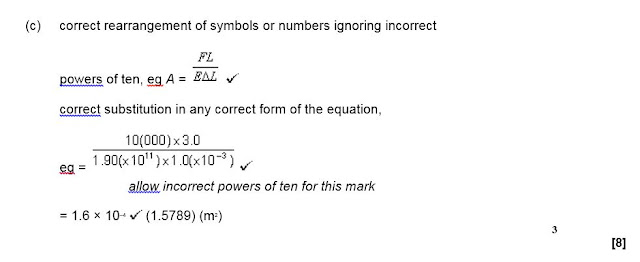3.4 Materials MS
M1.
(a) The candidate’s writing should be legible and the
spelling, punctuation and grammar should be sufficiently accurate for the
meaning to be clear. The candidate’s answer will be assessed holistically.
The answer will be assigned to one of three levels according to the following
criteria.
High Level (Good
to excellent): 5 or 6 marks
The information
conveyed by the answer is clearly organised, logical and coherent, using
appropriate specialist vocabulary correctly. The form and style of writing is
appropriate to answer the question.
Candidate must
suggest
· drawing
a graph of F vs ΔL (or vice versa)
· AND
that k is in some way linked to the gradient
· AND
use of a suitable named instrument to measure or determine extension
· AND 1
further means of reducing uncertainty: repeats / minimum 8 different readings /
use of vernier scale / check values of mass with balance / parallax elimination
with set square, pointer in contact with scale, mirror.
For 6 marks:
must also give
suitable range at least up to 10N but not beyond 20N (accept ‘up to 20N’ / ‘not
beyond 20N’)
AND minimum 8
different readings OR parallax elimination must be included
AND repeats
must be included
AND correctly
explains how k is obtained from their graph.
Intermediate
Level (Modest to adequate): 3 or 4 marks
The information
conveyed by the answer may be less well organised and not fully coherent. There
is less use of specialist vocabulary, or specialist vocabulary may be used
incorrectly. The form and style of writing is less appropriate.
Candidate must
suggest:
· to
measure / determine extension OR initial and final length
· AND to
use F = k ΔL or k = F / ΔL
OR drawing a graph of F vs ΔL (or vice versa)
· AND
use of suitable instrument to measure extension
OR 1 means of reducing uncertainty:
repeats / use of vernier scale / check values of mass with balance / parallax
elimination with set square, pointer in contact with scale,
mirror / minimum 8 different readings / graphical approach
For 4 marks, uncertainty
comment AND instrument required
Low Level (Poor
to limited): 1 or 2 marks
The information
conveyed by the answer is poorly organised and may not be relevant or coherent.
There is little correct use of specialist vocabulary. The form and style of
writing may be only partly appropriate.
Any relevant
statement from the marking points above
For 2 marks:
must mention minimum two points including:
· to
measure / determine extension OR initial and final length
6
(b) (i) (k
= 2 × 85 = 170 (N m–1) )
(ΔL = F
/ k =) 15 / 170 ( or 7.5 / 85 ) 
= 0.088  (m) (0.0882)
(m) (0.0882)
2
(ii) (k
= ½ × 85 = 42.5 )
(ΔL = F
/ k = ) 15/42.5 ( or 2 x 15/85) 
= 0.35  (m) (0.3529)
(m) (0.3529)
2
(iii) (W
= ½ FΔL or ½ k ΔL2)
= ½ × 15 ×
0.0882 ( or 2 x ½ × 7.5 × 0.0882)  ecf 5bi
ecf 5bi
= 0.66  (J) (0.6615) ecf 5bi
(J) (0.6615) ecf 5bi
2
(iv) (series)
greater  ecf for answer ‘less’ or ‘same’ where
candidates
ecf for answer ‘less’ or ‘same’ where
candidates
incorrect answers to bi and bii support this.
extension is
more (in series) and the force is the same
(in both situations) 
AND
quotes Energy stored = ( ½ )Fs or ½ FΔL OR energy proportional to
extension 
3
[15]
M2.
(a) tensile stress: (stretching) force (applied) per
unit
cross-sectional area (1)
tensile strain: extension (produced) per unit length (1)
2
(b)
Hooke’s law (or stress  strain) obeyed up to point A
(1)
strain) obeyed up to point A
(1)
A is limit of proportionality (1)
elastic limit between A and region B (1)
region C shows plastic behaviour or wire is ductile (1)
region B to C wire will not regain original length (1)
beyond region C necking occurs (and wire breaks) (1)
max 5
QWC
[7]
M3.
(a)
Suitable scale
on both axes (eg not going up in 3s) and > ½ space used 
≥
points correct (within half a small square) 
line is straight
up to at least stress = 2.5 × 108 and
curve
is smooth beyond straight section 
3
(b)
understanding that E = gradient (= Δy/Δx) 
allow y/x if
line passes through origin
= 1.05 × 1011 (Pa) (allow 0.90 to 1.1) ecf from their line
in (a)
if answer outside this range and uses a y
value ≥ 2 
when
values used from table;
•
two marks can be scored only if candidates line passes
through them
•
one mark only can be scored if these points are not on their line
2
[8]




